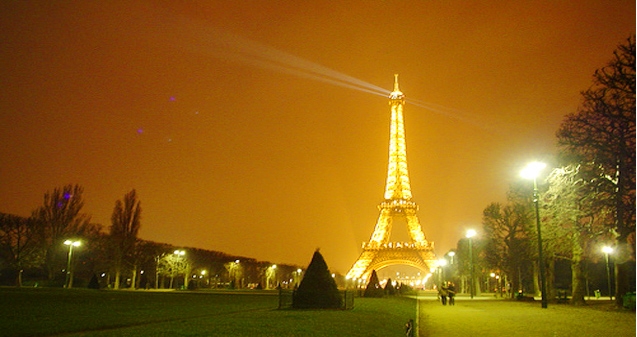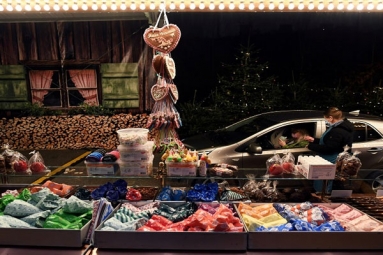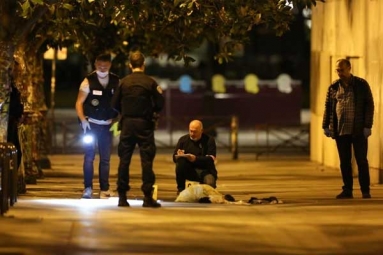
Once just a village that settled on the "Ile de la Cite" (City Island) on the confluence of the Seine's two branches, Paris has vastly expanded over the centuries, taking the surrounding villages under its wing and making them its own. Nowadays the City of Light—a name Paris earned during the age of the Enlightenment—is made up of several arrondissements or districts, numbered from one to 20 and logically ordered with the 1st in the center and the others following in a clockwise spiral. The differences are vast and varied between the districts, both in terms of the populations and attractions, which together make up the multifaceted city we know and love.
1st Arrondissement
With its impressive collection of paintings and sculptures, the Louvre attracts visitors from the world over, who often combine it with a stroll in the adjoining Tuileries gardens. Designers of haute couture, including Yves St-Laurent and Dior, have set up shop in Faubourg Saint-Honore , just a short walk from the majestic Place Vendôme , home to some of the finest jewelers in Paris. If luxury seems to be the prevailing feature in the 1st arrondissement, it has also lovingly accepted the Forum des Halles , the city's largest shopping center.
2nd Arrondissement
With its little back streets harboring galleries, cafes and boutiques, this district sets a typically Parisian scene. West of Rue Richelieu stands the theater district where a dozen or so playhouses throng. The Palais Brongniart reminds by-passers of what used to be the location of Paris' vibrant stock market, while certain clothing factories in the Sentier district are now home to Internet companies.
3rd Arrondissement
The Marais district prides itself on being one of the oldest and best preserved in Paris. In keeping with this yearning for yesteryear, a museum charting the history of the capital ( Musee Carnavalet ) can also be found here. Scattered with trendy bars, cafes and stylish boutiques, the Marais has also become the Mecca of gay nightlife in Paris.
4th Arrondissement
Undoubtedly one of the most picturesque districts. Wander across the bridge opposite the Hôtel de Ville (town hall) and you will drift onto the capital's two islands—Île de la Cite and Île Saint-Louis—where a visit to the stunning Notre-Dame Cathedral is an absolute must. Back on the right bank, Place des Vosges , a beautiful old square lined with ancient buildings, is a wonderful witness to times gone by.
5th Arrondissement
This and the adjoining 6th arrondissement comprise the Quartier latin (Latin Quarter), a bastion of student life and higher education in Paris. Within a 100-meter (328-foot) radius around the Pantheon you'll find some of the most prestigious schools and universities in all of France. The Jardin des Plantes , Paris' botanical gardens and zoo, is at once a calm and exotic place, and the Arènes de Lutèce (remains of a Roman amphitheater) remind us just how rich the history of Paris really is. You'll find the Musee National du Moyen-Âge in Cluny Square. As picturesque as you could possibly imagine, the quaysides double as an enthralling treasure trove of second-hand bookstalls. Come nightfall, the young crowds flock to Place de la Contrescarpe and Rue Mouffetard .
6th Arrondissement
Rue de Seine, de Buci, Mazarine and Dauphine, along with the whole area between Boulevard St-Germain and the river Seine itself, are wholeheartedly characteristic of the allure of Paris. Discover the little cafes and boutiques of the chic-intellectual district of Saint Germain des Pres , and the bars and nightspots when the sun goes down. If on the other hand you want to escape, take some peaceful time out in Jardin du Luxembourg .
7th Arrondissement
More commonly known as the quartier des ministres (ministers' quarter), the 7th district also boasts some of Paris' most beautiful monuments—the Invalides , the Eiffel Tower , the Champ de Mars—literally meaning "Field of Mars," which was originally a parade ground for cadets in the Ecole Militaire (Military Academy). Between Quai Voltaire and Rue de l'Universite, dozens upon dozens of antique dealers entice you into their shops on the Carre Rive Gauche, and if you are in an artistic frame of mind, the spectacular Musee d'Orsay is well worth a browse.
8th Arrondissement
Naturally, any visit to the 8th arrondissement has to start on the most beautiful avenue in the world—the fabulous Champs-Elysees - which extends from Place de l'Etoile down to the finishing post on Place de la Concorde . Also worth seeing is La Madeleine , a neoclassical church, and the parc Monceau , a jogger's paradise. Music lovers will find heaven in a shopping trip along Rue de Rome. Other places of interest include the Grand Palais and the Palais de la Decouverte (the Palace of Discovery), which makes the fascinating world of science accessible to all.
9th Arrondissement
Its impressive elegance makes the Opera (opera house) undeniably one of Paris' most exquisite monuments. You can take in the waxworks at Musee Grevin , and stroll through Nouvelles Athènes (New Athens) near the St-Georges metro, but this area is also characterized by large department stores, including Printemps and Galeries Lafayette .
10th Arrondissement
Running the entire length of the Canal Saint-Martin , the Quais de Valmy and de Jemappes extend either side of the water to provide one of the most delightful walks in Paris; from Rue du Temple to Place de Stalingrad you will pass many a lock and maybe the odd barge or two.
11th Arrondissement
Formerly the haunt of furniture craftsmen, the Bastille district now plays host to an entirely different scene: that of Paris' young and trendy in-crowd. Rue du Faubourg-St-Antoine has seen many restaurants and nightspots spring up and flourish. Neighboring Rue de Lappe is probably the place to be seen on an evening, while others prefer the buzz of Rue Oberkampf a little further north.
12th Arrondissement
Paris' pleasure beach can be found here, between the Seine and the Place de la Bastille , where the imposing Opera Bastille stands. The Palais Omnisport de Paris-Bercy serves as the venue for a variety of sporting and musical events, which often sell out very quickly, so be warned! Located to the far west of the city, but still within its limits, the Bois de Vincennes is a wonderful place to wander, especially around the lake.
13th Arrondissement
The easterly part of this district is known as "Chinatown," inhabited by numerous Chinese and Asian restaurants, shops and supermarkets. The Bibliothèque nationale de France (National Library) has also taken up residence in this area, overlooking the Quai de la Gare on the Seine. To the west of the district, meander through the small village of Butte-aux-Cailles—an extraordinary find in the capital city.
14th Arrondissement
Rue d'Alesia stands out for its array of clothing shops, while Parc Montsouris is arguably one of the most charming green spots in the city. The Cite Internationale, where international students reside, stands just opposite and is well worth a visit as it features architectural styles from all over the world. Finally, you can take a look at the Bronze Lion of Belfort or at Rodin's Balzac in Place Denfert-Rochereau.
15th Arrondissement
Set along the banks of the Seine, the delightful Parc Andre-Citroën in this district was, of course, named in honor of the famous car manufacturer. A little further north, overlooking the river, you'll find Paris' skyline of skyscrapers peering down at a replica (or did this one come first?) of the Statue of Liberty.
16th Arrondissement
There's no denying that this is the most fashionable district of Paris. The Trocadero offers a remarkable view of the city, as well as the Naval Museum ( Musee de la Marine ). Avenue Foch is destined to impress, as is Parc des Princes (Paris-Saint-Germain Stadium) . West of the ring road, roams the Bois de Boulogne forest, which although best avoided after dark, is a real delight during the day.
18th Arrondissement
The Basilique du Sacre-Coeur (the Basilica of the Sacred Heart) is another must-see monument in the City of Light. Looking up at the basilica from the market below is sure to take your breath away (as will all the steps you have to climb to reach it!). A short walk from the Sacre-Coeur takes you to Place du Tertre , drenched in the atmosphere of "old Paris" which cannot fail to captivate, even if it is teeming with tourists. Rue des Abesses, with its trendy boutiques and bars, draws a hipper kind of crowd alongside the famous Pigalle area—Paris' former red light district, and home to a famous cabarets and bars.
19th Arrondissement
The Cite des Sciences et de l'Industrie (Science and Industry Museum) was designed as Paris' window into the world of science. The Buttes Chaumont —an area of natural parkland—is the ideal place for a relaxing walk or a picnic.
20th Arrondissement
The most well-known cemetery in Paris, the Cimetière du Père-Lachaise is the final resting place of many famous artists, and is one of the most visited sites in the city. Memories of Jim Morrison are obviously still very much alive as his tomb is permanently carpeted with flowers. While the young artsy crowds of the city tend to hang out further and further to the east of the city—mainly in the Bastille district which is rapidly surrendering to consumerism—this area has managed to hold on to its working-class origins, hence its charm.
Source : Yahoo!Travel
















